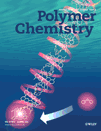Styrene–vinyl pyridine diblock copolymers: Synthesis by RAFT polymerization and self-assembly in solution and in the bulk
Abstract
Reversible addition-fragmentation chain transfer (RAFT) polymerization along with benzyl dithiobenzoate chain transfer agent was employed for the controlled preparation of four diblock copolymers of styrene (St, less polar monomer) and 2- or 4-vinyl pyridine (2VP or 4VP, more polar monomers): St161-b-2VP48, St161-b-2VP121, St161-b-4VP76, and St161-b-4VP107, where the subscripts indicate the experimentally determined degrees of polymerization for each block. These diblock copolymers and their common St homopolymer precursor were characterized in terms of their molecular weights and compositions using gel permeation chromatography and 1H NMR spectroscopy, respectively. All four diblock copolymers self-assembled in dilute toluene solutions to form reverse spherical micelles, which were characterized using atomic force microscopy and cryogenic transmission electron microscopy. Both microscopy techniques revealed that the 4VP-bearing diblock copolymers formed larger micelles than the 2VP-bearing ones, a result of the greater 4VP-toluene incompatibility as compared to the 2VP-toluene one. Finally, films cast from chloroform solutions of the diblocks were investigated in terms of their bulk morphologies using transmission electron microscopy. While the 2VP-containing block copolymer self-assembled into a spherical morphology, the 4VP-containing one with comparable composition and molecular weight formed a cylindrical structure, manifesting the greater 4VP-St incompatibility as compared to that of the 2VP-St pair. © 2012 Wiley Periodicals, Inc. J Polym Sci Part A: Polym Chem, 2012




